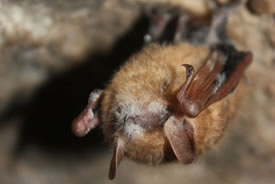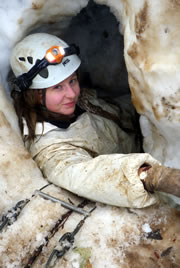Bad news for bats? How White-nose Syndrome threatens Canada's bat populations

Tri-colored bat with white-nose syndrome (Photo by USFWS)
Bats are an important part of Canada’s biodiversity. They eat huge numbers of insects, some of which are crop and forestry pests. In the U.S. alone, it is estimated that bats provide insect control services worth between $3.7 and $53 billion per year.
Of the 18 species of bats found in Canada, three are being considered for listing as endangered under the federal Species at Risk Act: the little brown myotis, northern myotis and tricolored bat. These three bat species have been severely impacted by White-nose Syndrome (WNS), putting them at risk of disappearing from Canada. Some populations have declined by 90 per cent in just three years. WNS is considered one of the most serious diseases to affect North American wildlife in the past century. It has killed nearly 7 million bats to date and threatens to devastate bat populations across the continent.
WNS is a fungal disease that affects bats during the winter while they are hibernating in caves or mines. The fungus grows on the nose and wings of bats, causing extensive damage. It is thought that the fungus causing WNS was inadvertently introduced by humans from Europe. Since it was first found in New York in 2006, WNS has spread hundreds of kilometres per year and is now established in 25 states and five provinces (as of April 2014). No cure has yet been found.
Bat species with the greatest mortality from WNS, such as the little brown bat, only produce one young per year, limiting the potential for recovery. WNS is not currently known to affect any other animal besides bats, and not all species are affected. Of the 48 bat species found in North America, so far six are known to suffer from WNS. Some bat species never enter caves and so are not exposed to WNS.
My research on WNS
My research, conducted out of the New Brunswick Museum with the support of the Canadian Wildlife Federation and other funders, encompasses three main areas: the study of cave fungi in relation to white-nose syndrome, monitoring bat populations and studying the cave environment. We have 10 caves in New Brunswick that we regularly monitor and take samples from every year. We started this work in 2009, before WNS arrived in the area. This means we were able to collect baseline data and determine what impact WNS has had on the bat population and the native cave fungi after it arrived in 2011. More detailed information on my research can be found here:
http://scholarcommons.usf.edu/ijs/vol42/iss1/9/
http://www.plosone.org/article/info%3Adoi%2F10.1371%2Fjournal.pone.0104684
http://canadianfieldnaturalist.ca/index.php/cfn/article/view/1327
http://www.canadianfieldnaturalist.ca/index.php/cfn/article/view/1231
http://www.eaglehill.us/NENAonline/articles/NENA-20-1/17-Vanderwolf.shtml
What you can do
Educate yourself and others on the biology of bats. You will find that many of the negative connotations and myths are not true! You can report bats sightings, roosting sites and over-wintering sites through local citizen science programs such as this one in Nova Scotia. This helps researchers learn more about bats and how to protect them.
Entering hibernation sites (Oct-May) or maternity colonies (May-Sept) when bats are present can disturb bats and increase mortality. It is best to stay out of caves and mines. This will limit the spread of the fungus, which is still present in caves even after bats have moved to summer roosts. If you must enter caves, carefully follow decontamination protocols to prevent the spread of WNS as outlined by the U.S. Fish and Wildlife Service. If you have a maternity colony in your home, consult information from Bat Conservation International to minimize disturbance.
You can also put up a bat box in your back yard! Bat boxes are only used by bats during the summer months and they like them as hot as possible.
Support forest and wetland conservation as habitat for bats and limit your use of pesticides. Or, plant flowers and shrubs that encourage moths, an important food source for bats.
Finally, you can also encourage the conservation of winter habitat for bats. Caves and mines can be protected from human disturbance by gating. This is particularly true for mines, which are often filled in once they are no longer used by humans.
Bats are fascinating and it would be a great loss if they were to disappear. Let’s do what we can to help them out!


